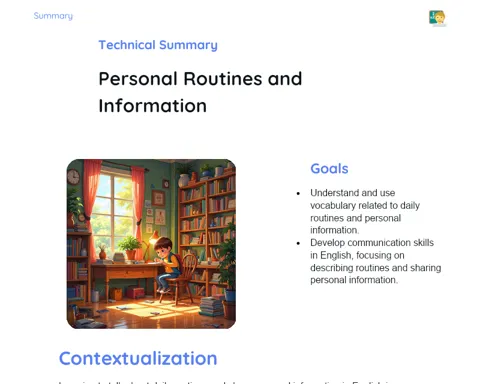Verbs: Simple Past and Present Perfect | Traditional Summary
Contextualization
Verbs are essential elements in any language as they indicate actions, states, and events. In English, understanding the different tenses is crucial for effective communication. Two of these tenses are the simple past and the present perfect. The simple past is used to describe actions that occurred at a specific time in the past, such as 'I visited my grandmother last weekend.' The present perfect connects the past to the present, indicating actions that occurred at an unspecified time but are relevant now, as in 'I have visited Paris.'
Mastering the difference between the simple past and the present perfect is fundamental, especially in professional and academic contexts. For instance, in English job interviews, the present perfect is often used to discuss past experiences and achievements that are relevant to the present. Therefore, understanding and correctly using these tenses can significantly improve your communication skills, both in writing and speaking.
Definition and Use of the Simple Past
The simple past is a verb tense used to describe actions that occurred at a specific time in the past. Examples include sentences like 'I visited my grandmother last weekend.' or 'She finished her homework yesterday.' These actions are often accompanied by specific time expressions such as 'yesterday', 'last week', 'in 2010', etc. The use of the simple past is straightforward and indicates that the action was completed in the past with no direct connection to the present.
The formation of the simple past for regular verbs is quite simple: just add '-ed' to the end of the base verb. For example, 'walk' becomes 'walked', and 'visit' becomes 'visited'. However, many verbs in English are irregular and do not follow this rule. For example, 'go' in the simple past is 'went', and 'see' is 'saw'. It is important to memorize these irregular verbs, as they are frequently used in daily communication.
The simple past is essential for narrating events and telling stories, as it provides a clear and defined timeline of actions. By constructing sentences in the simple past, the speaker helps the listener understand exactly when something happened, creating a clear and cohesive chronological narrative.
-
Used for actions at a specific time in the past.
-
Formation for regular verbs by adding '-ed'.
-
Irregular verbs have specific forms that need to be memorized.
Formation of the Simple Past
The formation of the simple past for regular verbs involves adding '-ed' to the end of the base verb. For example, 'play' becomes 'played', and 'start' becomes 'started'. However, it is important to note some basic spelling rules: if the verb ends in 'e', we only add 'd' (as in 'love' which becomes 'loved'), and if the verb ends in a consonant followed by 'y', we change the 'y' to 'i' before adding '-ed' (as in 'study' which becomes 'studied').
For irregular verbs, there is no specific rule, and each verb has its own past form. For example, 'go' becomes 'went', 'come' becomes 'came', and 'see' becomes 'saw'. These irregular verbs must be memorized, as they are common in the English language and do not follow the regular pattern of simple past formation.
Correct use of the simple past is essential for clarity in communication, especially in narrative contexts or when reporting events that occurred in the past. Understanding the formation of both regular and irregular verbs allows students to form precise and comprehensible sentences.
-
Addition of '-ed' to the end of regular verbs.
-
Spelling rules: endings in 'e' and 'y'.
-
Memorization of irregular verbs.
Definition and Use of the Present Perfect
The present perfect is a verb tense used to describe actions that occurred at an unspecified time in the past and that are relevant to the present. Examples include sentences like 'I have visited Paris.' or 'She has finished her homework.' Unlike the simple past, the present perfect does not indicate exactly when the action occurred, but rather that the action has some connection or impact on the present.
The formation of the present perfect involves using the auxiliaries 'have' or 'has' followed by the past participle of the main verb. For regular verbs, the past participle is formed by adding '-ed' to the base verb (as in 'watched' or 'played'). For irregular verbs, the past participle needs to be memorized, such as in 'gone' (from 'go') or 'done' (from 'do').
The present perfect is frequently used in contexts where the action in the past is relevant to the present. This includes questions about life experiences, recent actions that have an impact now, and situations where the specific time is not important. For example, in job interviews, the present perfect is used to discuss past experiences that are relevant to the current position.
-
Used for actions with relevance in the present.
-
Formation with 'have' or 'has' followed by the past participle.
-
Used in contexts that connect the past to the present.
Differences between Simple Past and Present Perfect
The main difference between the simple past and the present perfect lies in the time and relevance of the described actions. The simple past is used for actions that occurred at a specific time in the past and are viewed as completed. For example, 'I saw that movie last night.' clearly indicates when the action took place. In contrast, the present perfect is used for actions that occurred at an unspecified time in the past but have relevance in the present. For example, 'I have seen that movie before.' does not specify when the action occurred but suggests that the experience is relevant now.
Another important difference is the use of time expressions. The simple past is often accompanied by specific time expressions such as 'yesterday', 'last week', 'in 2010', etc. The present perfect, on the other hand, uses expressions like 'ever', 'never', 'already', 'yet', 'just', and 'recently', which do not specify an exact time but rather the relevance of the action to the present.
Understanding these differences is crucial for effective communication in English. Correct use of each verb tense helps convey the precise idea and avoid misunderstandings. Furthermore, mastery of these tenses is essential in academic and professional contexts, where clarity and precision in communication are key.
-
Simple past is used for completed actions at a specific time.
-
Present perfect is used for actions with relevance in the present.
-
Differences in time expressions used with each verb tense.
To Remember
-
Simple Past: Verb tense used for actions that occurred at a specific time in the past.
-
Present Perfect: Verb tense used for actions that occurred at an unspecified time in the past with relevance in the present.
-
Regular Verbs: Verbs that form the simple past and the past participle by adding '-ed'.
-
Irregular Verbs: Verbs that do not follow the regular formation rule and have specific forms in the simple past and past participle.
-
Time Expressions: Words or phrases that indicate when an action occurred, such as 'yesterday', 'last week', 'ever', 'never', etc.
Conclusion
In this lesson, we explored in detail the verb tenses of the simple past and the present perfect, their formations, and specific uses. The simple past is used to describe completed actions at a specific time in the past, as in 'I visited my grandmother last weekend'. The present perfect is used for actions that occurred at an unspecified time in the past but are relevant to the present, as in 'I have visited Paris'.
Understanding the difference between these verb tenses is essential for effective communication in English, especially in narrative and professional contexts. Correct use of the simple past and present perfect allows speakers to convey information clearly and precisely, avoiding misunderstandings. Additionally, mastery of these verb tenses is crucial in English job interviews, where the clarity and relevance of past experiences are often assessed.
We emphasize the importance of memorizing irregular verbs and the time expressions associated with each verb tense. Understanding and continuous practice of these grammatical concepts are fundamental for improving your writing and speaking skills in English. We encourage everyone to continue exploring and practicing these verb tenses to ensure more effective and confident communication.
Study Tips
-
Practice forming sentences in the simple past and present perfect daily, using regular and irregular verbs to solidify knowledge.
-
Read texts in English, such as articles, stories, and interviews, identifying and analyzing the use of the simple past and present perfect for better understanding of context and application.
-
Do grammar exercises focused on verb tenses and ask for feedback from peers or teachers to correct and improve your skills.



